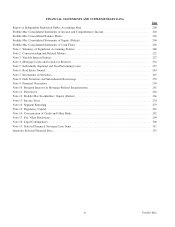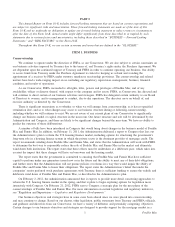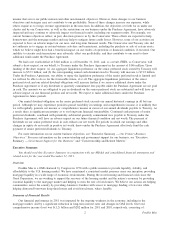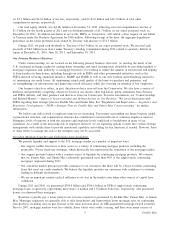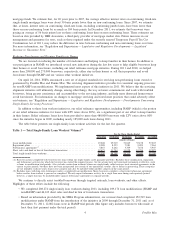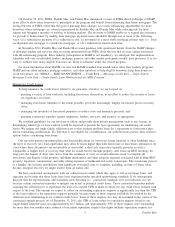Freddie Mac 2011 Annual Report Download - page 14
Download and view the complete annual report
Please find page 14 of the 2011 Freddie Mac annual report below. You can navigate through the pages in the report by either clicking on the pages listed below, or by using the keyword search tool below to find specific information within the annual report.on seriously delinquent loans in our portfolio, we expect our credit losses will continue to remain high even if the
volume of new serious delinquencies declines.
• Continued negative impact of certain loan groups within the single-family credit guarantee portfolio, such as those
underwritten with certain lower documentation standards and interest-only loans, as well as other 2005 through
2008 vintage loans. These groups continue to be large contributors to our credit losses.
• Cumulative declines in national home prices during the last five years, based on our own index. As a result of
these price declines, approximately 20% of loans in our single-family credit guarantee portfolio, based on UPB,
had estimated current LTV ratios in excess of 100% (underwater loans) as of December 31, 2011.
• Deterioration in the financial condition of many of our mortgage insurers, which reduced our estimates of expected
recoveries from these counterparties.
Some of our loss mitigation activities create fluctuations in our delinquency statistics. For example, loans that we
report as seriously delinquent before they enter a modification trial period continue to be reported as seriously delinquent
until the modifications become effective and the loans are removed from delinquent status by our servicers. See
“MD&A — RISK MANAGEMENT — Credit Risk — Mortgage Credit Risk — Single-family Mortgage Credit Risk —
Credit Performance —Delinquencies” for further information about factors affecting our reported delinquency rates.
Government Support for our Business
We are dependent upon the continued support of Treasury and FHFA in order to continue operating our business. Our
ability to access funds from Treasury under the Purchase Agreement is critical to keeping us solvent and avoiding the
appointment of a receiver by FHFA under statutory mandatory receivership provisions.
Under the Purchase Agreement, Treasury made a commitment to provide funding, under certain conditions, to
eliminate deficits in our net worth. The $200 billion cap on Treasury’s funding commitment will increase as necessary to
eliminate any net worth deficits we may have during 2010, 2011, and 2012. We believe that the support provided by
Treasury pursuant to the Purchase Agreement currently enables us to maintain our access to the debt markets and to have
adequate liquidity to conduct our normal business activities, although the costs of our debt funding could vary.
To address our net worth deficit of $146 million at December 31, 2011, FHFA, as Conservator, will submit a draw
request on our behalf to Treasury under the Purchase Agreement in the amount of $146 million. FHFA will request that
we receive these funds by March 31, 2012. Upon funding of the draw request: (a) our aggregate liquidation preference on
the senior preferred stock owned by Treasury will increase to $72.3 billion; and (b) the corresponding annual cash
dividend owed to Treasury will increase to $7.23 billion.
We pay cash dividends to Treasury at an annual rate of 10%. During 2011, we paid dividends to Treasury of
$6.5 billion. We received cash proceeds of $8.0 billion from draws under Treasury’s funding commitment during 2011.
Through December 31, 2011, we paid aggregate cash dividends to Treasury of $16.5 billion, an amount equal to 23% of
our aggregate draws received under the Purchase Agreement. As of December 31, 2011, our annual cash dividend
obligation to Treasury on the senior preferred stock exceeded our annual historical earnings in all but one period.
We expect to request additional draws under the Purchase Agreement in future periods. Over time, our dividend
obligation to Treasury will increasingly drive future draws. Although we may experience period-to-period variability in
earnings and comprehensive income, it is unlikely that we will generate net income or comprehensive income in excess of
our annual dividends payable to Treasury over the long term. In addition, we are required under the Purchase Agreement
to pay a quarterly commitment fee to Treasury, which could contribute to future draws if the fee is not waived. Treasury
waived the fee for all quarters of 2011 and the first quarter of 2012, but it has indicated that it remains committed to
protecting taxpayers and ensuring that our future positive earnings are returned to taxpayers as compensation for their
investment. The amount of the quarterly commitment fee has not yet been established and could be substantial.
There continues to be significant uncertainty in the current mortgage market environment, and continued high levels
of unemployment, weakness in home prices, and adverse changes in interest rates, mortgage security prices, and spreads
could lead to additional draws. For discussion of other factors that could result in additional draws, see “RISK
FACTORS — Conservatorship and Related Matters — We expect to make additional draws under the Purchase Agreement
in future periods, which will adversely affect our future results of operations and financial condition.”
On August 5, 2011, S&P lowered the long-term credit rating of the U.S. government to “AA+” from “AAA” and
assigned a negative outlook to the rating. On August 8, 2011, S&P lowered our senior long-term debt credit rating to
“AA+” from “AAA” and assigned a negative outlook to the rating. While this could adversely affect our liquidity and the
supply and cost of debt financing available to us in the future, we have not yet experienced such adverse effects. For more
9Freddie Mac



